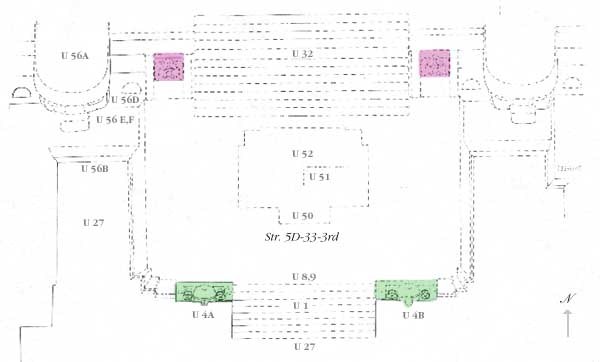

Diagram is from William Coe, Tikal Report no. 14
Scroll down to see Unit 4A/B (green) and Unit 196 (pink)
Coe writes that the existence of Str5D-33-3rd "remained unsuspected until 1963, when lateral Terrace-based tunneling...revealed the huge U 4B mask, as well as contiguous substructural components, ending beyond at a ragged line indicating demolition...suggesting that 33-3rd's summit was dismantled in preparation for erecting 2nd.
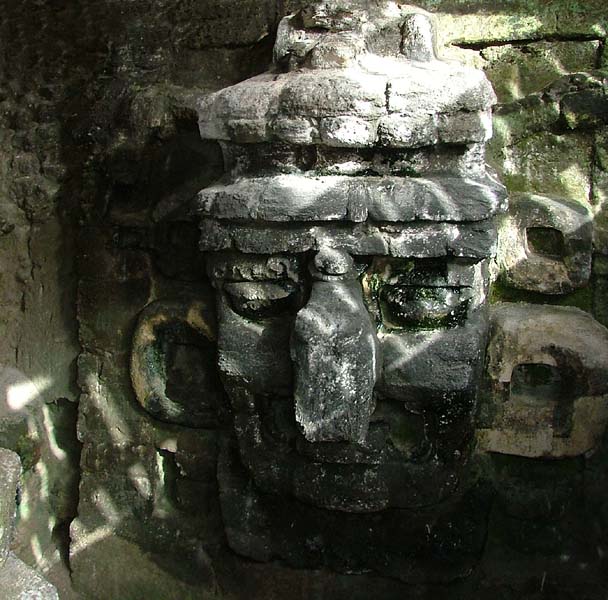
The platform of 33-3rd is faced by two masks over ten feet high depicting long-nosed gods, one to the east and one to the west. Both are visible today by way of a system of tunnels and are among the most awesome sights of Tikal.
Each owes its good preservation to the fact that the Maya covered them over with new masks at the time of building 33-2nd. But at the time of building 33-1st, these masks were brutally hacked and almost completely stripped of their red and white painted decorative plaster.
William R. COe, Tikal: A Handbook of the Ancient Maya Ruins, p. 46
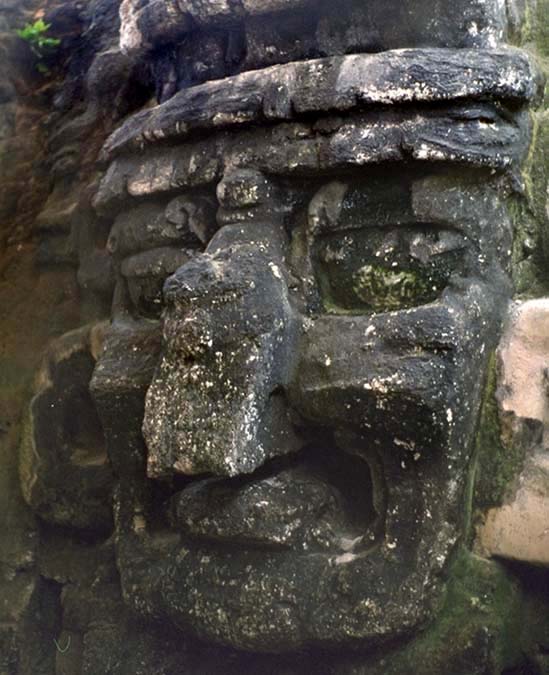
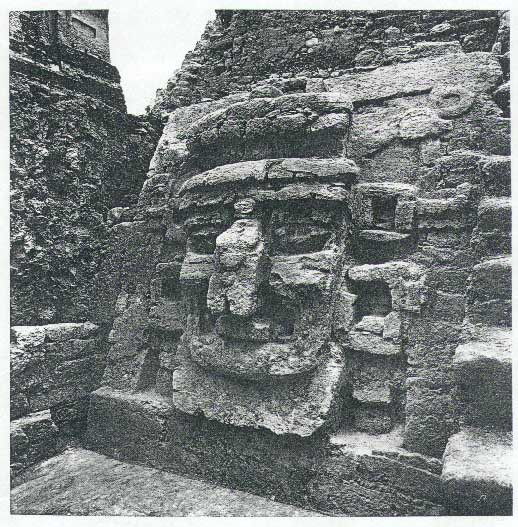
Coe, William, Tikal Report no. 14, fig. 316
The mask as it appeared before the protective thatch structure was put in place. 4A is the left member of the pair of masks 4A/4B straddling the stairway
Visitors today can climb down a short stairwas to stand at the base of the masks, which are somewhat lower than the terrace on the platform of the demolished 5D pyramid.

Coe, Tikal Report no. 14, fig. 316
"Termed U. 196, an upside-down composition, as first encountered behind Structure 5D-34-1st masonry. One of probably four like features arrayed across the facade of the Platform 5D-4-3rd-B Acrpolis."
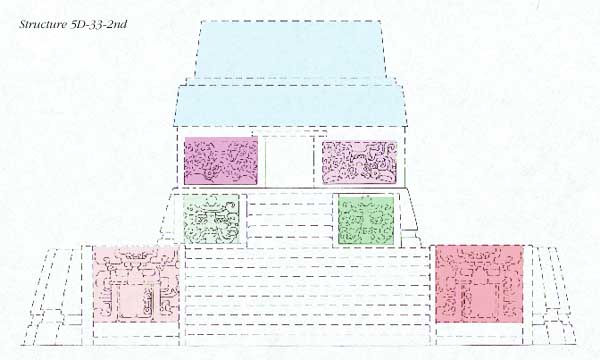
Str. 5D-33-2nd is late Early Classic. It replaced 33-3rd, and was itself eventually totally interred beneath 33-1st.
Toward the end of the Late Classic, Tikal was surrounded by enemies. It was defeated in 562 AD by the city of Caracol and entered a period of humiliation and silence which lasted for 150 years. Toward the end of this period, the 25th ruler of Tikal, Shield Skull, worked to revive the power of Tikal. He cultivated diplomatic and possibly military alliances with the city-states of Palenque and Copan, and took captives in battle against the rival Yaxchilan in August of 659. Shield Skull died in battle in AD 672.
Hasaw Chan K'awil, son of Shield Skull and perhaps Tikal's greatest ruler, became 26th ruler in the succession on 3 May 682 and immediately set about renewing the prestige of his city. Many of his initial actions centered around the termination of Temple 5D-33-2nd and the construction of the revolutionary temple 5D-33-1st over it in honor of his father.
Coe, William, Tikal Report no. 14, fig. 166.
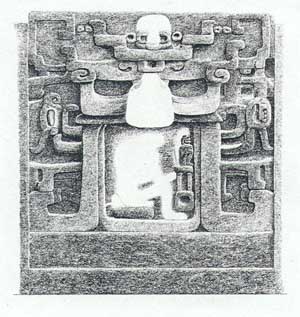
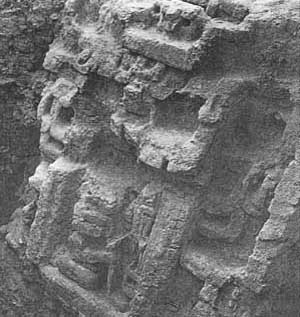
New U5 panels flanked the stairway of 33-2nd and covered the U4 stair panels from the old 33-3rd. "Utterly differing from those featured by 33-3rd, their focus seems to have been a profiled individual (perhaps holding a crouched animal with pendent element) seated between large, geometric mouth volutes belonging to a grotesque visage, in turn crowned centrally by a human face (remnants of the latter appear on the building platform panels). Little more than U. 5A's masonry under-pinnings existed, for finish stucco was ruined on the occasion of U. 6A remodeling...the U.5 panels terminated above as slightly raised, rectangular parts, their fundamental purpose likely to divert runoff, thus minimizing facial erosion.
William Coe, Tikal Report 14, vol II, p. 512
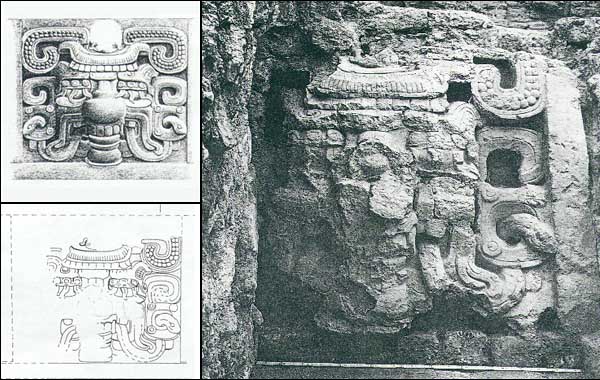
Coe, William, Tikal Report no. 14, figs. 182 & 319
Linda Schele identifies this figure as a mountain monster with snakes emerging from its mouth.
Linda Schele & Peter Mathews, The Code of Kings, p. 73
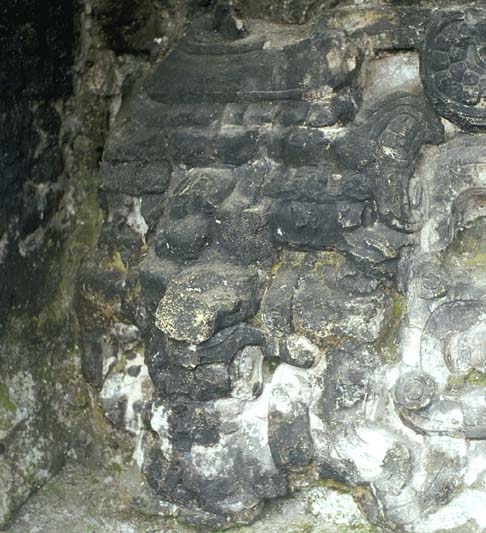
"Snake Mountain, the place where civilization was invented...had a ballcourt at its base. In mythology, water from the ballcourt irrigated the land around Snake Mountain and gave abundant harvests to the people. The people of Mutil [Tikal] constructed their Snake Mountain as Temple 33-2nd in the front of the North Acropolis. They identified it by covering its terraces with plaster masks of mountain monsters with snakes emerging from their mouths."
Linda Schele and Peter Mathews, The Code of Kings, p. 73.
The eroded image of Snake Mountain visible today in the North Acropolis has lost much detail, but the reconstruction drawing illustrates how the original looked.
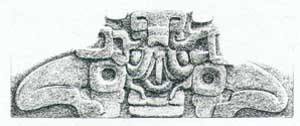
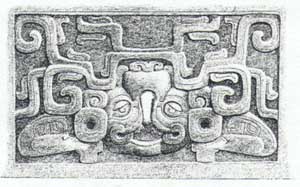
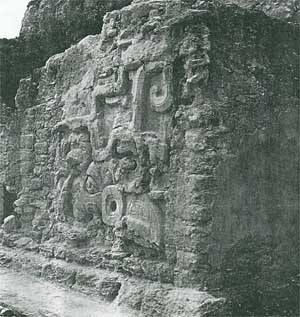
Coe, William, Tikal Report no. 14, figs. 184 & 316
"It is doubtful that, either before or afterwards, was architectural decoration carried to such an extreme...As argued above, the building's upper zone, even a conjectural roofcomb, was distinguished by exceedingly ornate stuccowork. The building also bore end-grooved recessed panels on its sides and rear; moreover, much if not its entirety stood painted red. From appearances, what was erected persisted unaltered, save for radical restructuring of the basal masks and subtle modification of the upper-most panels."
William Coe, Tikal Report 14, vol II, p. 514
The panels flanking the entrance to Temple 5D-33-2ndhave been uncovered and now are viewed from the North Acropolis.

Fig. 185: Sample of material from either the building's upper zone, roofcomb, or both
"Dismantled eventually [in preparation for construction of 33_1st], the upper building facade and presumed roofcomb are believed to have borne elaborate stuccowork, a deduction from myriad broken material met in 5D-33-1st fills (principally specimens in Fig. 185)."
William Coe, Tikal Report 14, vol II, p. 511